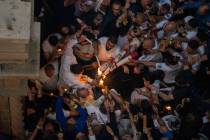Hospital death sign of crisis
NEW YORK -- When staff members at a Brooklyn hospital spotted a middle-aged woman lying facedown on a waiting room floor last month, the sight hardly seemed like cause for alarm.
It was common in the psychiatric emergency room at Kings County Hospital Center. The unit is so routinely backed up with people waiting hours, or days, for services that patients often spend the night nodding in chairs or sprawled in a corner.
An hour passed before a nurse realized the prone woman was in trouble. By then, she was dead.
Security camera footage of the woman drew outrage when it became public this week. Experts said the incident is an extreme symptom of a crisis occurring in hospitals nationwide.
Emergency rooms, they said, have become all-purpose dumping grounds for the mentally ill, with patients routinely marooned a day or more while health care workers try to find someone to care for them.
A survey of hundreds of U.S. hospitals released last month by the American College of Emergency Physicians found that 79 percent reported that they routinely "boarded" psychiatric patients in their waiting rooms for at least some period of time because of the unavailability of immediate services.
One-third reported that such stays averaged at least eight hours, and 6 percent said they had average waits of more than 24 hours for the next step in a patient's care.
"We try to find a place to put them," said Dr. David Mendelson, an emergency physician in Dallas who wrote the ACEP report. That place should be a quiet spot with one-on-one nursing care, he said, but that does not always happen.
"Unfortunately, sometimes the only thing we can do is restrain them or medicate them," he said.
There are many reasons for the delays, which vary from city to city, but doctors said they usually boil down to one thing: a lack of available mental health services.
Some communities have shortages of clinicians and few open beds at psychiatric hospitals. Sometimes, insurance companies refuse to approve treatment, and patients must wait while doctors appeal. Other times, patients are not sick enough to need inpatient care but would be lost if discharged to the street. Finding a program to look after them can take days, doctors said.
"There's no place to put them in the community, so we literally hold onto them," said Dr. Michael Cohen, director of the emergency psychiatric unit at Stony Brook University Medical Center on Long Island.
Esmin Green, a poor immigrant from Jamaica, had been in the waiting room at King's County Hospital Center for almost 24 hours when she toppled from her chair the morning of June 19.
Security camera tapes showed that, for an hour, no one who saw the 49-year-old sprawled on the floor bothered to check her condition, including the unit's attending psychiatrist and two guards.
Doctors are trying to determine a cause of death.
Six hospital workers were fired after she died, and the city agreed to reduce overcrowding and trim the time patients spend in the unit. Hospital administrators promised to improve conditions in the unit, which had been deplored in a recent lawsuit.
The lawsuit, which is pending, alleged the long waits for care at King's County could be cruel. Patients had limited access to linens, gowns or soap. The showers were filthy, and few places to sleep existed.
Every hospital emergency room in the city feels the pressure of being used as a dumping for the city's mentally ill, said Joyce Wale, senior assistant vice president of behavioral health at the New York City Health and Hospitals Corporation, which runs the city's public hospitals.
Said Cohen: "It's the police. It's the schools. It's health clinics, all sending people to the emergency room, when these people don't really need to be there."























